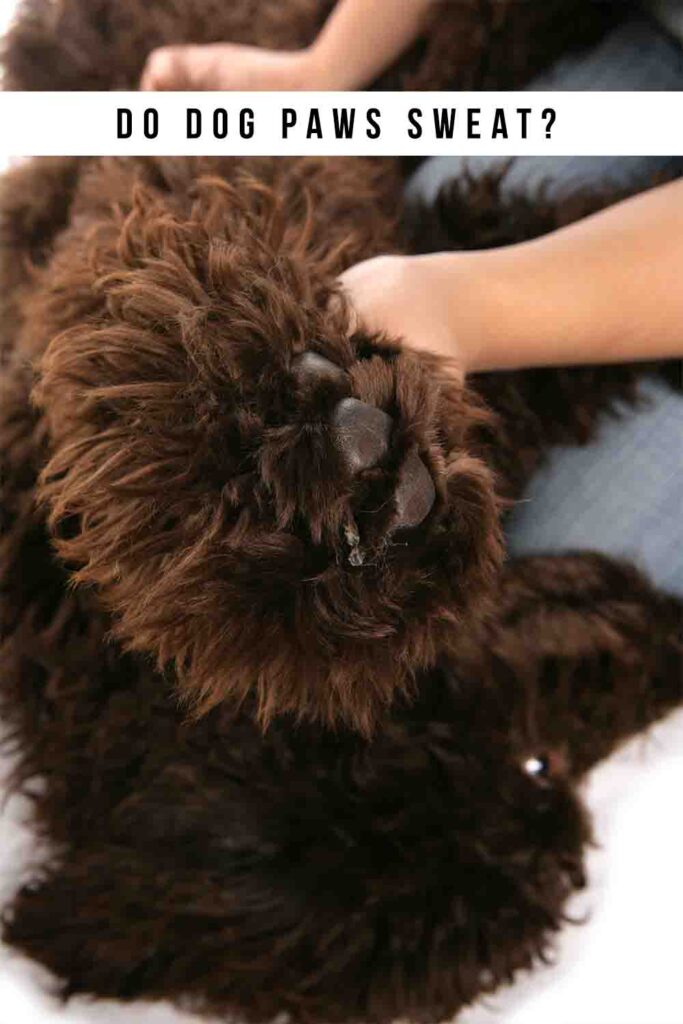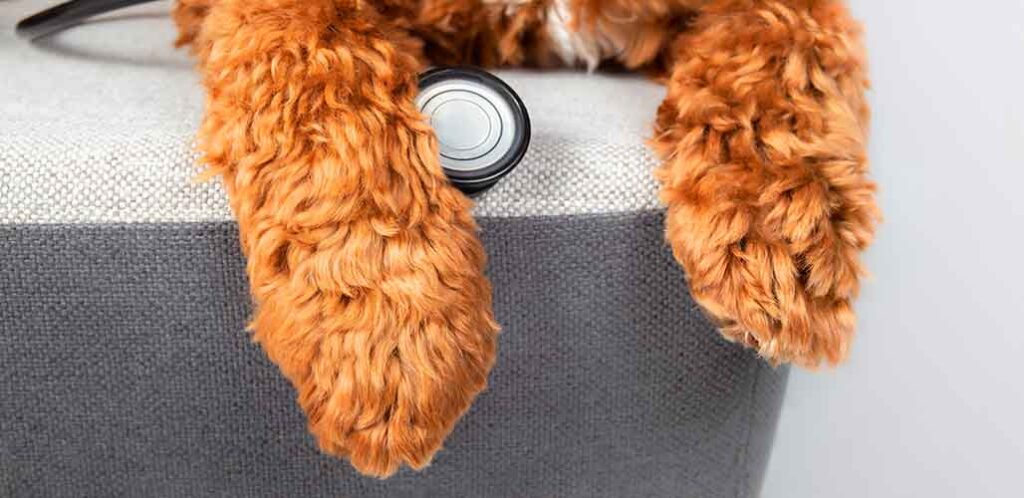Do dog paws sweat? Do they get clammy feet like we get clammy palms when we’re nervous? I’ve had pups whose paws left wet foot prints on the veterinarian’s table, and pets who didn’t. Those wet paw prints are indeed sweat, and all dogs sweat from their paws when it’s hot, to help cool down. But it’s not their only way of regulating their temperature. They might also get sweaty feet in other situations, but this depends on the context and the individual. So let’s take a closer look at why and when puppies (and adults) perspire from their paws!
Contents
Do dog paws sweat?
Yes! Dogs have have eccrine glands in their paw pads. These are a type of sweat gland which produce clear, sterile, watery sweat, with a small concentration of dissolved salts and minerals. The primary function of eccrine sweat is evaporative cooling – as the sweat evaporates, it cools the skin beneath it, and also the blood just beneath the skin’s surface. As that blood returns to the heart, it cools the center of the body too. But whilst temperature regulation is the primary purpose of sweaty paws, sweaty paws are not the primary way that dogs regulate their temperature.
Huh?
I’ll explain! Sweating from their paws is not the most important adaptation dogs have to keep them cool on hot days. Which is just as well, because their paw pads make up a relatively tiny proportion of the surface their body. Imagine an 80 pound Labradoodle trying to keep cool on a warm day through just the soles of their feet, which are in contact with the ground half the time anyway!
No, dogs’ foremost way of keeping cool is by panting. When they pant, the air cools the blood circulating around the airways in their nose. This hardly sounds like a larger surface area than their paws, but those airways are surrounded by a highly specialized type of tissue called turbinates. These turbinates greatly increase the surface area across which blood can be cooled by the incoming air.

What makes dog paws sweat?
Hot days aren’t the only thing that make dogs’ paws sweat. It can also be triggered by some emotional states, such as fear, anxiety, stress, and stress. Their paws might also sweat as a response to physical pain from disease or injury. Usually if sweaty feet are part of an emotional reaction to something, there will be other physical or behavioral clues as well, like:
- Shaking or trembling
- Drooling
- Raised hackles
- Rapid blinking, or ‘whale eye’
- Licking their nose
- Yawning
Stressed or nervous dogs might also pant more, but this isn’t very useful for telling whether a dog’s paws are sweating due to heat or nerves!
Does the smell of dog’s feet come from sweat?
Have you noticed that your dog’s feet have a smell a bit like popcorn or corn chips? Most dogs’ do, and dog owners tend to be divided into the people who out-and-proud love it, and those who only secretly love it (no one could actually hate it though, right?)
Now that we’ve established their paws do sweat, does it mean that their distinctive aroma from their feet is the smell of their sweat? Not at all in fact! The sweat glands on dog’s feet are eccrine sweat glands – the sweat they make is mostly water, and odorless. The sweat glands which make smelly sweat are apocrine sweat glands. Apocrine sweat is thicker and oily. It’s also odorless, but its consistency traps bacteria, which starts to smell as it decays. Dogs do have apocrine sweat glands as well, but they are distributed over the hairy parts of their body, and they’re partly responsible for the doggy odor in their coat.
So where does the smell of dog paws come from, if not from sweat? Well, the answer is straight forward and well established – that distinctive aroma comes from naturally occurring colonies of Pseudomonas bacteria. They’re completely normal, and nothing to worry about.
Top tips for keeping those paw pads healthy
Sweating is a normal function of healthy paws. Here’s how to make sure they stay healthy!
- Trim their nails regularly. The anatomy of dogs’ feet is perfectly adapted for ease of movement. If their nails grow long enough to press into the ground, it changes the mechanics of how the foot moves, placing stress on the bones and joints, and causing pain.
- Trim the fur between their toes. If your pup grows long fur between his toes, it can irritate the skin, cause the foot pads to slide on smooth surfaces, and trap moisture that increases the risk of fungal infections. So, trim it gently every time you tidy his nails.
- Choose suitable shampoos. Dogs’ skin is naturally more alkaline than ours, so if you regularly need to wash their paws after a walk, use plain water or products formulated specifically for dogs. Products designed for people (even babies) will irritate their skin.
- Clean away salts. Speaking of paw washing, always rinse your dog’s paws after going out on sidewalks that have been gritted in winter, or the salt in the grit will irritate their skin (and if they lick it away, could make them sick).
- Stay off sidewalks in hot weather. Dogs can burn their paw pads on surfaces like asphalt or concrete that have been heated by the sun. If in doubt, test them with your hand before your set out!
- Monitor for changes of appearance or smell. Dogs instinctively mask pain, so not putting weight on one of their feet isn’t always the first sign that something is wrong. Check their feet regularly for any changes in how the skin looks, feels, or smells.
Do dog paws sweat – summary
Dogs do sweat from their paws, and the purpose of the sweat glands on their paw pads is to cool the skin (and therefore the dog) down in hot conditions. However, when your dogs paws sweat, it could also be a sign that they are stressed – you’ll need to look for more clues from their environment and their behavior to tell which one it is!
Does your pooch get sweaty paws? Let us know in the comments box down below!

